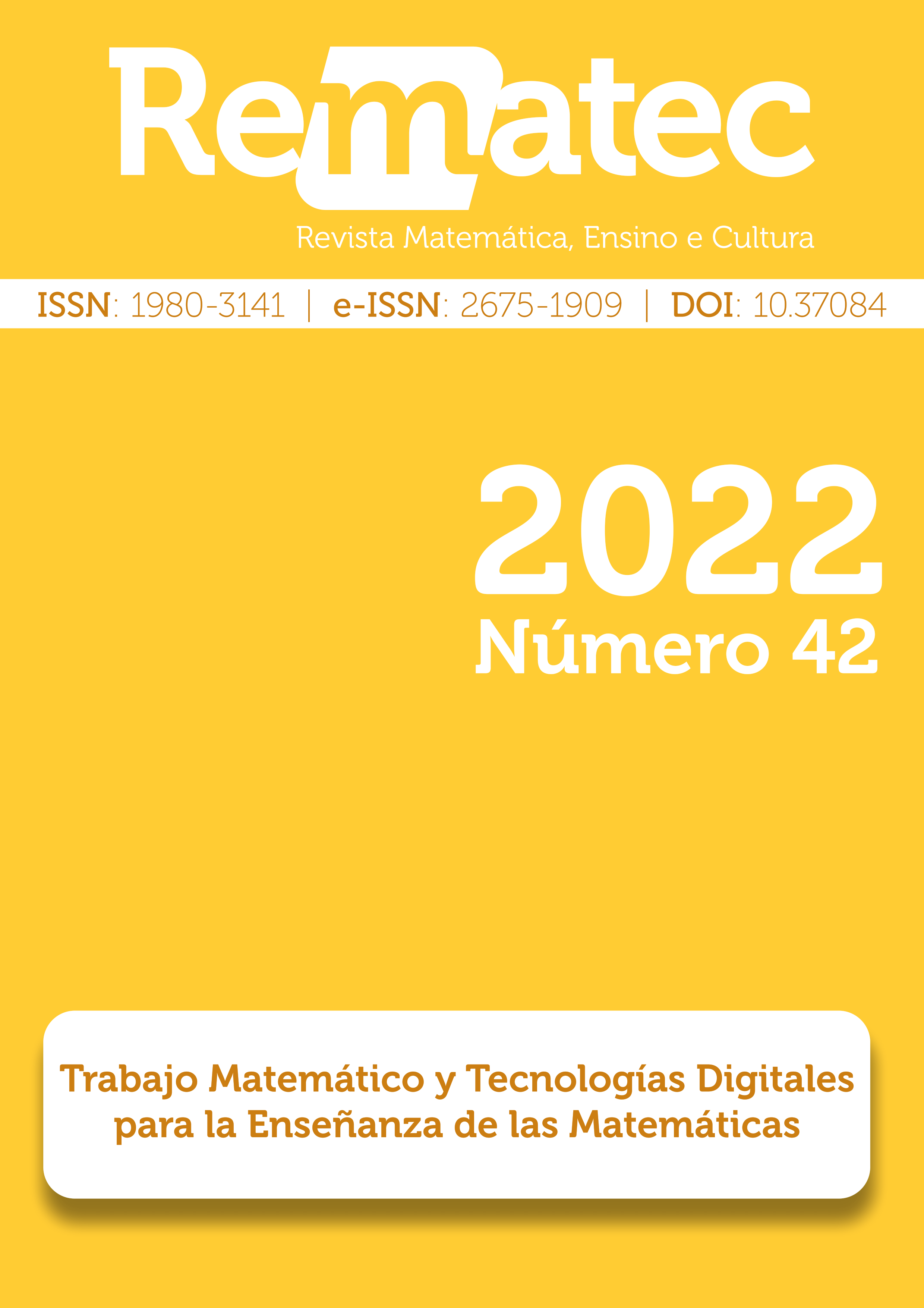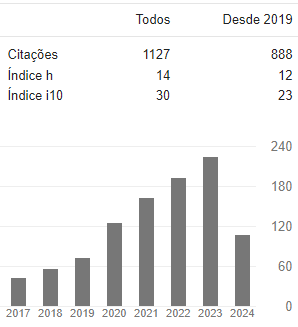Valor Epistémico de Tareas Diseñadas en un Sistema de Evaluación en Línea con Retroalimentación para Matemáticas
DOI:
10.37084/REMATEC.1980-3141.2022.n42.p111-138.id453Palavras-chave:
Profesores, Espacio de Trabajo Matemático, función, programación, diseño de tareasResumo
La participación de los profesores en el diseño de recursos digitales ha cobrado importancia el último tiempo, particularmente en el diseño de recursos para la evaluación en línea. Este artículo busca caracterizar el valor epistémico de un conjunto de tareas diseñadas y programadas por un dos profesores en un sistema de evaluación en línea para matemáticas en una institución de educación superior en Chile. El valor epistémico es estudiado a través del Espacio de Trabajo Matemático idóneo potencial mediante un análisis cualitativo de los enunciados de las tareas diseñadas, las retroalimentaciones y los algoritmos que los definen. Los resultados muestran que se privilegia un trabajo instrumental incluso en tareas donde se usan registros gráficos. También, aparecieron fenómenos particulares ligados a la parametrización y programación de tareas, los cuales impactan el valor epistémico de estas.
Downloads
Métricas
Referências
ARTIGUE, M. Learning mathematics in a CAS environment: The genesis of a reflection about instrumentation and the dialectics between technical and conceptual work. International Journal of Computers for Mathematical Learning, v. 7, n. 3, p. 245–274, 2002. DOI: https://doi.org/10.1023/A:1022103903080
ARTIGUE, M. Tecnología y enseñanza de las matemáticas : desarrollo y aportaciones de la aproximación instrumental II . De la programación a los recursos en línea : trayectoria de una investigadora. Cuadernos de Investigación en Educación Matemática, v. 8, p. 1–15, 2011.
ATTALI, Y. Effects of multiple-try feedback and question type during mathematics problem solving on performance in similar problems. Computers & Education, v. 86, p. 260–267, 2015. DOI: https://doi.org/10.1016/j.compedu.2015.08.011
ATTALI, Y.; KLEIJ, F. VAN DER. Effects of feedback elaboration and feedback timing during computer-based practice in mathematics problem solving. Computers & Education, v. 110, p. 154–169, 2017. DOI: https://doi.org/10.1016/j.compedu.2017.03.012
BALACHEFF, N. La transposition informatique. Note sur un nouveau problème pour la didactique (A. Michèle et al., Eds.)Vingt ans de didactique des mathématiques en France. Hommage à Guy Brousseau et Gérard Vergnaud. Anais...Grenoble: La Pensée Sauvage Éditions, 1994
BARANA, A.; MARCHISIO, M.; SACCHET, M. Interactive feedback for learning mathematics in a digital learning environment. Education Sciences, v. 11, n. 6, 2021. DOI: https://doi.org/10.3390/educsci11060279
BÉGUIN, P.; RABARDEL, P. Concevoir pour les activités instrumentées. Revue d’Intelligence Artificielle, v. 14, n. 1–2, p. 35–54, 2000.
BOKHOVE, C.; DRIJVERS, P. Effects of feedback in an online algebra intervention. Technology, Knowledge and Learning, v. 17, n. 1–2, p. 43–59, 2012. DOI: https://doi.org/10.1007/s10758-012-9191-8
BRIANT, N.; BRONNER, A. La prise en compte des nombres idécimaux pour le traitement du concept d’équation : une variable didactique oubliée. Recherches en didactique des mathématiques, v. 37, n. 1, p. 101–143, 2017.
CHEVALLARD, Y. L’analyse des pratiques enseignantes en théorie anthropologique du didactique. Recherches en didactique des mathématiques, v. 19, n. 2, p. 221–266, 1999.
CHOW, A. F. Online homework impact in undergraduate mathematics and business statistics courses. Educational Studies, v. 41, n. 3, p. 244–248, 2015. DOI: https://doi.org/10.1080/03055698.2014.961902
COUTAT, S.; RICHARD, P. Les figures dynamiques dans un espace de travail mathématique pour l’apprentissage des propriétés géométriques. Annales de Didactique et de Sciences Cognitives, v. 16, p. 97–126, 2011.
DUVAL, R. Registres de représentation sémiotique et fonctionnement cognitif de la pensée. Annales de didactique et de sciences cognitives, v. 5, n. 1, p. 37–65, 1993.
FLORES SALAZAR, J. V.; GAONA, J.; RICHARD, P. Mathematical work in the digital age: variety of tools and the role of geneses. Em: KUZNIAK, A.; MONTOYA, E.; RICHARD, P. (Eds.). . Mathematical Work in Educational Context - the Mathematical Working Space Theory perspective. Cham: Springer International Publishing, 2022. p. 165–209. DOI: https://doi.org/10.1007/978-3-030-90850-8_8
GAONA, J. et al. Feedback by automatic assessment systems used in mathematics homework in the engineering field. Computer Applications in Engineering Education, v. 26, n. 4, p. 994–1007, 2018. DOI: https://doi.org/10.1002/cae.21950
GAONA, J. et al. Elaboración de un sistema de evaluación en línea como proceso de formación de profesores de matemáticas. [s.l.] Université Sorbonne Paris Cité - Université Paris Diderot, 2018.
GAONA, J. et al. Diseño de tareas en un sistema de evaluación en línea, una mirada desde la Teoría de Espacios de Trabajo Matemático. Pädi. Revista de Didáctica de las Ciencias y la Ingeniería, v. 5, n. 10, 2022.
GAONA, J.; HERNÁNDEZ, R.; BRAVO, F. G. Y V. Influence of a function’s coefficients and feedback of the mathematical work when reading a graph in an online assessment system. International Journal of Emerging Technologies in Learning (iJET), 2022. DOI: https://doi.org/10.3991/ijet.v17i20.32641
GAONA, J.; LÓPEZ, S.; MONTOYA-DELGADILLO, E. Learning complex numbers using different CAS and an CAA in prospective mathematics teacher. International Journal of Mathematical Education in Science and Technology, p. 1–27, 2022. DOI: https://doi.org/10.1080/0020739X.2022.2133021
GAONA, J.; MENARES, R. Argumentation of prospective mathematics teachers in fraction tasks mediated by an online assessment system with automatic feedback. Eurasia Journal of Mathematics, Science and Technology Education, v. 17, p. 1–18, 2021. DOI: https://doi.org/10.29333/ejmste/11425
GONZÁLEZ, J. A. et al. A web-based learning tool improves student performance in statistics: A randomized masked trial. Computers & Education, v. 55, n. 2, p. 704–713, 2010. DOI: https://doi.org/10.1016/j.compedu.2010.03.003
HATTIE, J.; TIMPERLEY, H. The Power of Feedback. Review of Educational Research, v. 77, n. 1, p. 81–112, 1 mar. 2007. DOI: https://doi.org/10.3102/003465430298487
HENRÍQUEZ-RIVAS, C.; KUZNIAK, A.; MASSELIN, B. The Idoine or Suitable MWS as an Essential Transitional Stage Between Personal and Reference Mathematical Work. Em: KUZNIAK, A.; MONTOYA-DELGADILLO, E.; RICHARD, P. R. (Eds.). . Mathematical Work in Educational Context: The Perspective of the Theory of Mathematical Working Spaces. Cham: Springer International Publishing, 2022. p. 121–146. DOI: https://doi.org/10.1007/978-3-030-90850-8_6
HOYLES, C. et al. Cornerstone Mathematics: Designing digital technology for teacher adaptation and scaling. ZDM - Mathematics Education, v. 45, n. 7, p. 1057–1070, 2013. DOI: https://doi.org/10.1007/s11858-013-0540-4
JONES, K.; PEPIN, B. Research on mathematics teachers as partners in task design. Journal of Mathematics Teacher Education, v. 19, n. 2–3, p. 105–121, 2016. DOI: https://doi.org/10.1007/s10857-016-9345-z
KUZNIAK, A.; MONTOYA-DELGADILLO, E.; RICHARD, P. Mathematical Work in Educational Context. Cham: Springer International Publishing, 2022. DOI: https://doi.org/10.1007/978-3-030-90850-8
KUZNIAK, A.; NECHACHE, A.; DROUHARD, J. P. Understanding the development of mathematical work in the context of the classroom. ZDM - Mathematics Education, v. 48, n. 6, p. 861–874, 2016. DOI: https://doi.org/10.1007/s11858-016-0773-0
KUZNIAK, A.; RICHARD, P. Espacios de trabajo matemático. Puntos de vista y perspectivas. Revista Latinoamericana de Investigación en Matemática Educativa, v. 17, n. 4, p. 1–8, 2014. DOI: https://doi.org/10.12802/relime.13.1741a
KUZNIAK, A.; TANGUAY, D.; ELIA, I. Mathematical Working Spaces in schooling: an introduction. ZDM - Mathematics Education, v. 48, n. 6, p. 721–737, 2016. DOI: https://doi.org/10.1007/s11858-016-0812-x
MENARES ESPINOZA, R.; VIVIER, L. Personal Mathematical Work and Personal MWS. Em: KUZNIAK, A.; MONTOYA-DELGADILLO, E.; RICHARD, P. R. (Eds.). . Mathematical Work in Educational Context: The Perspective of the Theory of Mathematical Working Spaces. Cham: Springer International Publishing, 2022. p. 91–120. DOI: https://doi.org/10.1007/978-3-030-90850-8_5
MONTOYA, E.; MENA-LORCA, A.; MENA-LORCA, J. Circulaciones y génesis en el espacio de trabajo matemático. Revista Latinoamericana de Investigación en Matemática Educativa, v. 17, n. 4–1, p. 191–210, 2014. DOI: https://doi.org/10.12802/relime.13.1749
MONTOYA-DELGADILLO, E.; REYES AVENDAÑO, C. G. The Reference Mathematical Working Space. Em: KUZNIAK, A.; MONTOYA-DELGADILLO, E.; RICHARD, P. R. (Eds.). . Mathematical Work in Educational Context: The Perspective of the Theory of Mathematical Working Spaces. Cham: Springer International Publishing, 2022. p. 73–90. DOI: https://doi.org/10.1007/978-3-030-90850-8_4
ROSCHELLE, J. et al. Online Mathematics Homework Increases Student Achievement. AERA Open, v. 2, n. 4, p. 1–12, 2016. DOI: https://doi.org/10.1177/2332858416673968
SANCHO-VINUESA, T.; ESCUDERO, N. ¿Por qué una propuesta de evaluación formativa con feedback automático en una asignatura de matemáticas en línea? Revista de Universidad y Sociedad del Conocimiento, v. 9, n. 2, p. 59–79, 2012. DOI: https://doi.org/10.7238/rusc.v9i2.1285
STACEY, K. et al. Specific mathematics assessments that reveal thinking: an online tool to build teachers’ diagnostic competence and support teaching. Em: LEUDERS, T.; PHILIPP, K.; LEUDERS, J. (Eds.). . Diagnostic Competence of Mathematics Teachers. Mathematics Teacher. Cham: Springer, 2018. p. 241–261. DOI: https://doi.org/10.1007/978-3-319-66327-2_13
STACEY, K.; WILIAM, D. Technology and assessment in mathematics. Em: CLEMENTS, M. A. K. et al. (Eds.). . Third international handbook of mathematics education. New York: Springer, 2013. p. 721–751. DOI: https://doi.org/10.1007/978-1-4614-4684-2_23
VÁSQUEZ, M.; GAONA, J. Sistema de evaluación dinámica online en matemática para desarrollar el estudio autónomo fuera del aula (SEDOL-M ) (V. Sánchez, Ed.)III Congreso de Innovación Educativa. Anais...Monterrey: TecLabs, Tecnológico de Monterrey, 2016
Downloads
Publicado
- Visualizações do Artigo 294
- PDF downloads: 234







 Português (Brasil)
Português (Brasil)
 Español (España)
Español (España)
 English
English






























































